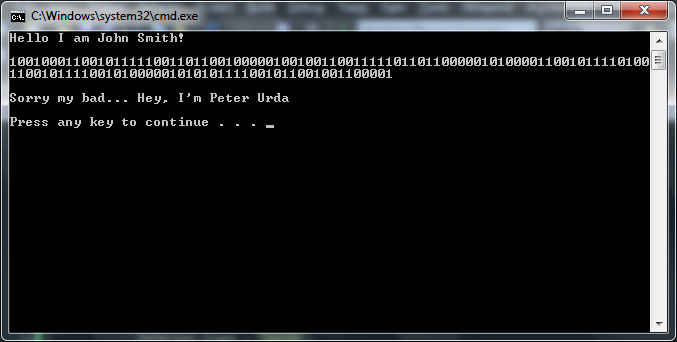Build Objects With Interfaces
Being able to drop certain chunks of code from one piece of software to another piece of unrelated software is a powerful thing. Not only does this save time, but it will also allow you to build a small library of tools you find useful in all your applications. Interfaces in C# is just one of many ways to build more modular objects that have similar behavior.
We are going to create an interface IHuman to build people objects from. Everyone can agree that all people have a First Name, Last Name, Age, and have some ability to speak. So we will wrap that up into a neat interface.
public interface IHuman
{
string fname { get; set; }
string lname { get; set; }
int age { get; set; }
void Speak(string input);
}
An interface is a very basic chunk of code in C#. It is like a checklist of objects and actions that all derived classes should have. The way each class handles each dimension of the IHuman will be unique to each class. So now we will create just a basic person object from the interface. I will then use Visual Studio to implement the interface, and this will be the result:
public class Person : IHuman
{
public string fname
{
get
{
throw new NotImplementedException();
}
set
{
throw new NotImplementedException();
}
}
public string lname
{
get
{
throw new NotImplementedException();
}
set
{
throw new NotImplementedException();
}
}
public int age
{
get
{
throw new NotImplementedException();
}
set
{
throw new NotImplementedException();
}
}
public void Speak(string input)
{
throw new NotImplementedException();
}
}
As you can tell, you’ll need to go through each method and implement it for use. I simply took a moment to do some clean up, and added logic to my Speak method:
public class Person : IHuman
{
public string fname
{
get;
set;
}
public string lname
{
get;
set;
}
public int age
{
get;
set;
}
public void Speak(string input)
{
Console.WriteLine(input);
}
}
Now I can build a simple program and declare a Person Object. Then I can set variables within the object and/or use any of the methods associated with it. Yet, I need another object to describe a programmer. Again, I’ll use the IHuman interface and make the needed changes to my methods. I’m also adding a custom method in this class as another way to speak.
public class Programmer : IHuman
{
public string fname
{
get;
set;
}
public string lname
{
get;
set;
}
public int age
{
get;
set;
}
public void Speak(string input)
{
string result = "";
foreach (string s in input.Select(c => Convert.ToString(c, 2)))
{
result += s;
}
Console.WriteLine(result);
}
public void DudeInPlainEnglish(string input)
{
Console.WriteLine("Sorry my bad... " + input);
}
}
If you pull the interface and two objects together, you can build a simple console application to prove this proof of concept:
static void Main(string[] args)
{
Person MyPerson = new Person();
MyPerson.fname = "John";
MyPerson.lname = "Smith";
MyPerson.age = 25;
MyPerson.Speak(string.Format("Hello I am {0} {1}!",
MyPerson.fname,
MyPerson.lname));
Console.WriteLine();
Programmer Me = new Programmer();
Me.fname = "Peter";
Me.lname = "Urda";
Me.age = 21;
string UrdaText
= string.Format("Hey, I'm {0} {1}", Me.fname, Me.lname);
Me.Speak(UrdaText);
Console.WriteLine();
Me.DudeInPlainEnglish(UrdaText);
Console.WriteLine();
}
Running the program will produce this output:
As you can tell the Programmer spits out binary when asked to speak, and it is only when you call the DudeInPlainEnglish method against it is when you get a readable format. The method also appends “Sorry my bad…” to the start of the print out.
If we only had access to the interface, we would know what properties and methods that each class must have when using said interface. Think of this interface as a type of contract, where each class that uses it must (in some fashion) use the properties and methods laid out. You can also think of an interface as a very basic framework for all involved classes.
So the next time you are working on a bunch of objects that are closely related to each other, consider using an interface.
